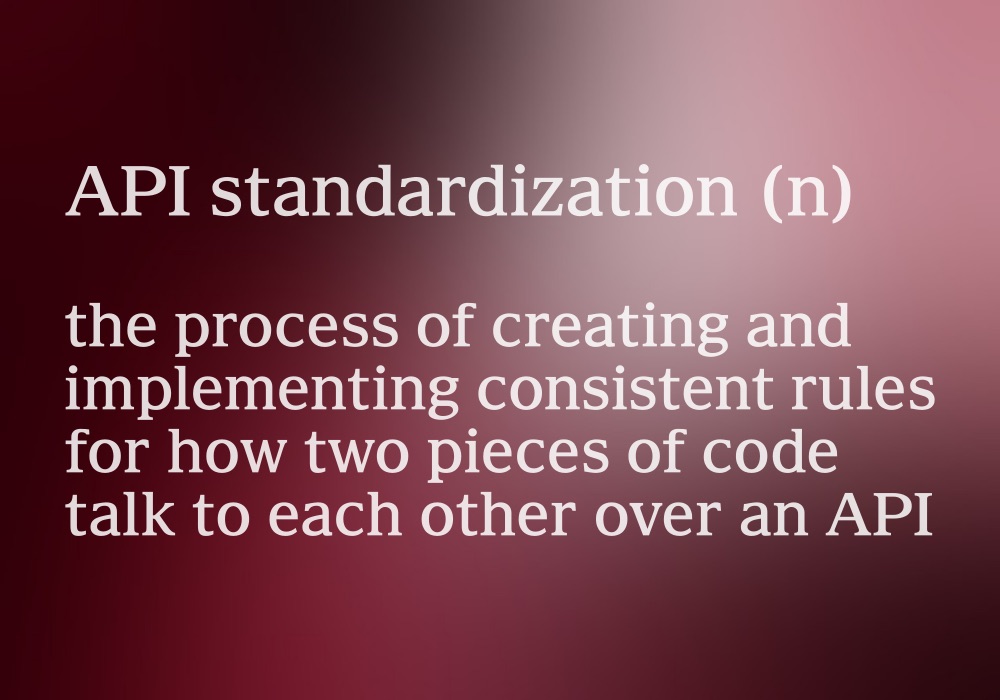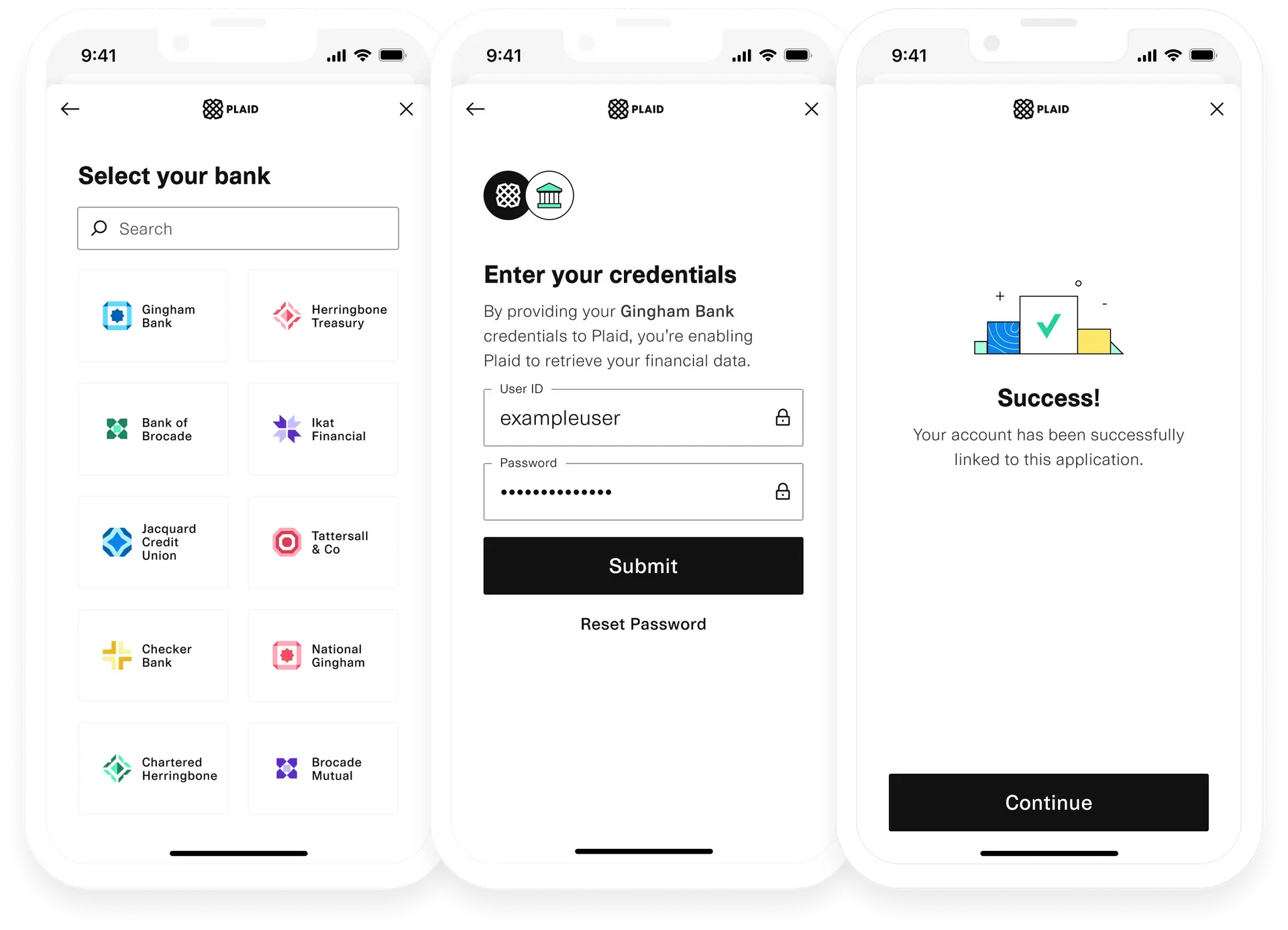It's just a simple fact of life that more work (and better work) gets done when everything is well-structured and organized. That's why, for example, professional chefs keep clean kitchens, precise timings, and ordered hierarchies of responsibilities.

It's the same reason why, if you regularly work at a desk, you probably make some effort to keep it organized (or at least you want to). Especially developers — who work in a strictly-structured world of math and logic — love straightforward direction in the form of standards.

Preview
This is why we need standardized Application Programming Interfaces (APIs): the more our API design reflects the consistency developers are expecting, the more productive they'll be with it and the more valuable it'll be to the devs and the API provider.
When we're done here, you'll be able to answer these three questions:
- What is API standardization and what does it look like in practice?
- How do standardized APIs actually help in general and in my industry?
- What can help lower the API standardization barrier-to-entry?
What is API Standardization?
You know what an API is: it's just the layer of glue between two pieces of code. Technically, it applies to almost every communication between modules inside an application, as well as to every external communication to some other program. That means that every time you have two pieces of code talk to each other, they have to have agreed in advance on what kind of communication they're going to use.
For example, maybe they'll use the JSON format, and they'll send messages to each other like this:
{
result: "success",
data: {
message: "Hello from across the API!"
}
}
Now, if this API is completely inside your application, you might be fine with just sending little packets of JSON like this between pieces of code. But the moment you start dealing with more complexity, you'll realize this approach to APIs doesn't scale well. Think about all the possible edge cases:
- Will the response JSON always contain a result key?
- What happens if the operation wasn't a success? Where will details about the error be stored?
- Is the body of the response always inside data? Or is it sometimes at the root level of the object?
You probably have experience building an API like this. Maybe you've directly worked through these questions with your API, or maybe not, but if you can think of definitive answers to them, then you're delving into API standardization. You're setting rules for how the pieces of code talk to each other so that it'll be completely consistent across your app.
A definition
With that example in mind, now we have enough information to write a more succinct definition:
👉 API standardization (n): the process of creating and implementing consistent rules for how two pieces of code talk to each other over an API (Application Programming Interface)

Those consistent rules might include coming up with answers to questions such as:
- In what format will the data be sent, both in the request and in the response?
- What naming convention will we use? Are we sticking with camelCase, snake_case, or something else for variable, resource, function, and endpoint names?
- How do the standards in our industry affect our ruleset?
You're a talented dev though; you know APIs go way beyond just two files sending tiny JSON packets back and forth.
API definitions over the internet
A company (called the service provider) might let you and your program interact with their programs over the Internet. The HTTP protocol that governs this already gives us some standardization to work with, but the body of each request is almost completely unsupervised. Imagine the chaos if every time we wanted to interact with, say, the Google Maps API, we could send our requests in whatever form we wanted! It'd be almost impossible for the service provider to pick out the needed data from our request, and even if it did, it'd probably be extremely slow. Let's focus on this use case from here on out to try and figure why API standardization isn't just a nice-to-have, but a crucial element of modern, efficient Information Technology.
Importance of API Standardization
What are the benefits of having standardized APIs for external services? Here's a few reasons:
1. It gets everybody collaborating
When API consumers can trust that it's straightforward to interact with the service and build what they want without too much unnecessary hassle, they'll be motivated to go further out of their way to work with others to solve problems.
2. It keeps the bugs to a minimum
It's way easier to avoid unintended functionality when security and predictability are baked right into the messages servers and clients send to each other. This has the effect of increasing the expected uptime of the API and reducing interruptions in service provision.
3. It promotes scalable innovation on the provider's side
When the service provider already has established the input and output of a particular endpoint or function, much of the grunt work involved in adding new features goes away. Standardized APIs open up tons of future prospects moving forward because the developers building the API can afford to be more creative.
4. It simplifies documentation and improves developer experience
Developers already keep track of enough, so if the learning curve is too high to interact with an API, they'll just avoid it. API standardization simplifies docs because we can remove all of the things that the rules make too obvious or too redundant to explain again. Standardization means developers can more easily find what they're looking for in the docs, flattening the learning curve and making the API more approachable to a wider range of users.
5. It reduces long-term technical debt in actual implementations
If the communication both between modules and to outer systems is standardized with an API and consistent rules, it removes the complexity that would otherwise need to be managed in the future, which helps to reduce operational costs that would come with it.
API Standardization Use Cases
Healthcare
Standardized Application Programming Interfaces are incredibly important in healthcare because data scattered among many systems affects how doctors and pharmacists work. For example, imagine you moved from South Carolina to Louisiana, so your providers, insurance company, pharmacies, and other healthcare connections all changed. What if, because the providers in South Carolina didn't have an easy, standardized API to upload your current prescriptions to a centralized database, your new healthcare providers in Louisiana prescribed you a conflicting medicine and damaged your health?
Smart API design prevents potentially life-threatening gaps in data sharing, and that's one of the biggest reasons why API standardization has gained industry-wide adoption in healthcare.
Government
Public services are notoriously difficult to use. Just the word “bureaucracy” comes with negative connotations because workers in different departments have the reputation of (to put it kindly) preferring to keep necessary information to themselves. In contrast, APIs are designed to bring people together through data and promote efficient information technology. No wonder standardized APIs have been a digital transformation in the government sector.
For the United States government, there's an official standard that requires several main objectives to be fulfilled:
- Make it available to everyone by putting new APIs in the directory.
- Use the API outer layer common to all government APIs for analytics, authentication, and security.
- Get versioning right. Wondering how? See our recent article on what makes API versioning so necessary and how to do it.
- Build public docs. Thankfully, this is way easier because we're working with standardized APIs.
- Have a feedback mechanism where users can report issues and ask questions. Feedback builds trust and also helps retain API users who are having trouble and are ready to quit.
- Use OpenAPI spec files to make it clear to users how to access the APIs, and make sure these OpenAPI specs don't suck!
- Use the normal endpoint design. Creativity is usually a positive, but once it starts causing mass confusion, it's not worth it.
You're not bound to these rules, but it might be worth implementing them at your company because they're a great way to make sure the principles of API standardization come through in the actual implementations you build.
Financial Services
Financial service technology (a.k.a. “fintech”) companies love APIs and standardization. There's a couple particularly strong reasons:
First, the modern shift toward open banking means customers are just expecting financial institutions to easily talk to each other. For example, in some countries you can set up investment accounts to pull directly from your bank. As a modern user would expect, there was no copy-and-pasting routing numbers, no hacky tiny deposits, no three-day wait, because they have standardized APIs (probably served via Plaid) for connecting the two accounts.

Also, many smaller companies don't have the infrastructure to run payment data themselves. A typical small business would find it way easier to use something like Stripe, a company that created API definitions for payment methods, invoices, charges, refunds, and every other piece of the payment process. That means that by using their API, we can get from hypothetical ideas to actual implementations really quickly.
Third, like we mentioned earlier, standardized APIs have plenty of security benefits too. That's especially great for fintech companies because they deal with extreme amounts of regulation to prevent data leaks and keep their customers' money and business data safe.
And as always, they're businesses that want to distinguish themselves from the competition. By adopting the principles of standardized APIs, they can focus on innovation and coming up with new ideas that'll grow the business.
How liblab Can Help With API Standardization
One of the biggest benefits of creating standard API definitions for endpoints and resources is that it allows you to automate building Software Development Kits (SDKs) out of your API.
That's where liblab comes in. Before, a small change in how your API worked meant you had to update every piece of code that used the API. But by putting liblab into your workflow, you can automatically generate the language-specific libraries through which your customers and clients will use your tool straight from the API design file, written to the OpenAPI spec. This means that you won't be bothered by the language-specific bugs and intricacies that would normally drag down a project that others depend on — instead, you'll get to efficiently spend time on what strengthens future prospects moving forward, like new API features and performance optimizations.
A pitch for standardized Application Programming Interfaces
Want a quick pitch to bring to the folks in charge of your APIs? Here's a summary of what we've learned so far:
- APIs need consistency to be useful.
- API standardization helps facilitate developer collaboration, simplify maintenance, promote faster innovation, make the developer experience more enjoyable, and limit technical debt.
- Many industries needed API standardization, and how they implemented it can help you decide how to implement it at your company to improve your future prospects.
- liblab's experts can help you through it. Benefit from our expertise by signing up for liblab.
Now that you're an expert in API standardization, set yourself up for long-term success by partnering up with liblab and automating SDK generation based on your standardized Application Programming Interfaces.
